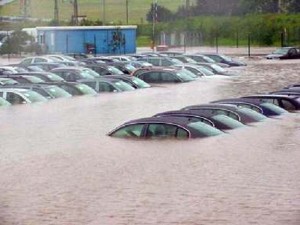
If you're not careful, someone might try to sell you one of these vehicles damaged by Superstorm Sandy.
Massive piles of debris have yet to be removed from some of the areas hardest hit by Superstorm Sandy, and it could be years before the damage is fully totaled up, never mind repaired, but adjusters have come up with a fairly conclusive tally of the automotive impact, an insurance industry trade group reporting that 250,500 vehicles were damaged or destroyed when the disaster hit the East Coast last October.
About 150,000 of those were in New York, according to the National Insurance Crime Bureau, which serves a major group of insurance companies. That’s actually an increase since an earlier estimate of about 130,000 in the Empire State.
And even the latest list may underestimate the extent of the damage, warns a statement from the NICB which says, “These are insured losses only. There are certainly many uninsured vehicles that were damaged by Sandy and those numbers are not reflected in this information.” It’s not clear if vehicles that aren’t covered by insurance companies that aren’t members of the trade group were also left out of the new count.
The good news – if there is any – is that the quarter-million number includes many vehicles that experienced only minor damage, such as paint scratches and broken windows. The NICB did not release a figure breaking down its count so there is no way to know how many vehicles were totaled or suffered more serious damages.
But the organization did issue a warning that, “By now there could be many Sandy damaged vehicles that are in the process of being reconditioned and sold to unsuspecting consumers all across the country. It is not illegal to buy or sell flood vehicles, or vehicles declared as salvage, as long as the parties to the sale are aware of the vehicle’s status.”
The problem is that there are plenty of unscrupulous parties who will try to avoid making such disclosures because it could lead to a lower sale price. In most states, flood-damaged vehicles will have clearly marked titles. But seasoned scammers have found ways to move the metal around the country in a process appropriately known as “title-washing,” and can sometimes expunge a vehicle’s record.
There are a number of services that assist consumers in tracking a complete vehicle history, including the NICB’s VINCheck, which provides access to the salvage records of insurance companies participating in the trade group. They write about 88% of U.S. auto insurance policies. Those who suspect fraud can call 1-800-TEL-NICB, or 1-800-835-6422.
TheDetroitBureau.com also offers some tips on how to track a flood-damaged car. Click Here for more.
While NY was clearly hardest hit, next on the list was New Jersey, where anything located near the Garden State’s 100s of miles of waterfront was fair game for the punishing storm. Residents had 60,000 vehicles on the new NICB tally.
By comparison, Connecticut, third on the list accounted for 8,000 vehicles damaged or destroyed by Sandy. The storm, however, covered a wide swath of American real estate, coastal states from Maine to North Carolina suffering vehicle losses, while the damage even reached as far inland as Ohio, where 4,000 vehicles were added to the NICB list.
